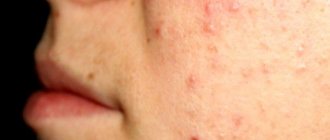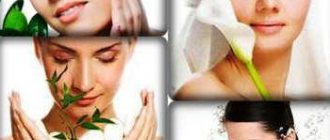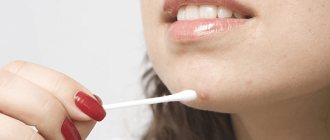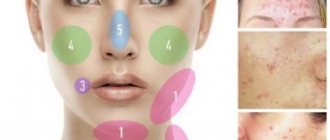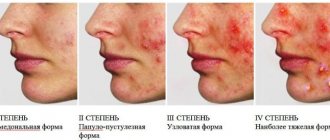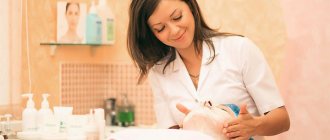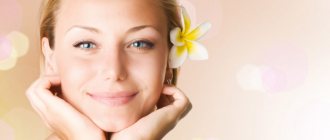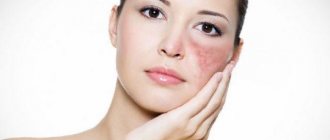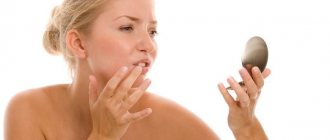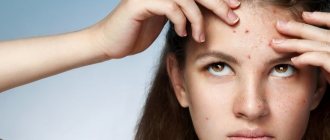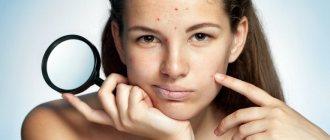Acne is not only common during adolescence. Often a similar phenomenon is observed in adults. Pimples most often appear on the face, although they can cover the back, neck, and other surfaces. In the first stages, treatment with home remedies is possible. But if the cases are advanced, it is better to consult a dermatologist for professional advice on therapy.
Etiology and pathogenesis (11 reasons)
The causes of acne on the face are varied. An important role in the occurrence of the problem is played by:
- genetic predisposition;
- hormonal changes;
- endocrine disorders;
- contact with chemicals;
- excessive pressure or friction (eg, tight headgear);
- errors in nutrition;
- using inappropriate cosmetics;
- neuropsychiatric disorders;
- skin damage and infection;
- insufficient hygiene;
- taking hormonal drugs.
Increased sebum secretion is a prerequisite for the proliferation of bacterial infections, the development of inflammation and acne.
Acne is accompanied by increased keratinization of the epithelium in the hair follicles. When the horny scales do not have time to peel off, the ducts of the sebaceous gland become clogged and the release of its secretion to the outside is disrupted.
As a result, sebum and dead cells accumulate at the mouth of the hair follicle, clog the pore and form a blackhead.
Further, the process worsens, the amount of secretion that does not come out increases, which leads to the expansion of the hair follicle, pores, and atrophic processes in the sebaceous gland.
Favorable microflora for pathogenic microorganisms is formed inside. The reproduction and release of waste products of bacterial agents irritate the tissues, causing local inflammation.
Do not squeeze pimples, blackheads and pustules.
All this crap needs to be removed correctly, otherwise you introduce an additional infection under your skin, which provokes even more serious inflammation and can even cause scarring .
Regularly carry out cleanings from specialists, or if you do them at home, then follow all recommendations and monitor sterility. This is not a joke, a squeezed pimple will become the source of serious problems, but how many of these have you squeezed out in a week? That's it... run to the cosmetologist!
Age range of the disease (3 categories)
Acne occurs at almost any age: from birth to old age. Previously, this problem was considered a teenage problem, but today it can be a concern regardless of a person’s age and gender.
Based on this, pathology is classified into the following categories:
- Baby acne (3-6 months). They arise against the background of the action of maternal hormones that were obtained during intrauterine development. Less commonly, they occur against the background of congenital diseases (for example, adrenal tumors). Features: closed, often located on the forehead, nose, chin, look like white or yellowish papules (milia), disappear on their own.
- Juvenile acne (12-17 years). They occur more often against the background of hormonal changes. With properly selected skincare cosmetics and cosmetic procedures, they disappear on their own by the age of 20.
- Acne in adults. This category includes rashes that occur even at 40-50 years of age. May bother men and women. The causes and treatment methods for facial acne are varied.
The problem can arise in adulthood due to hormonal imbalance (pregnancy, breastfeeding, menopause, taking hormonal contraceptives, abortion, etc.). In this case, acne disappears on its own after hormonal levels normalize.
If late acne is constantly present, then perhaps the problem lies in a disruption of the urinary and/or reproductive systems (for example, ovarian cysts, inflammatory diseases of the genital organs), infectious parasites, poor diet, long-term use of potent medications, etc.
For therapy to be effective, the cause of the problem must first be identified and eliminated.
Even if you often get acne, you should not forget to moisturize your skin.
Dermatologist Hadley King (New York)
Decoding
The Acne Map allows you to understand the meaning of acne and its formulation. All kinds of rashes, including acne in the neck area, indicate malfunctions in the internal system of the body.
Forehead area
Diseases of the stomach and nearby organs responsible for processing food are accompanied by rashes on the forehead. When propionobacteria spread, new acne appears, and the skin acquires an unhealthy shine. If acne does not appear and the oily skin does not disappear, then it is better to go check the gastrointestinal tract, because oily skin is directly related to malfunctions of the digestive system.
When acne on the forehead appears exactly above the eyebrow, the problem may be hidden in the gallbladder or pancreas. It is unlikely that there was a malfunction in the intestines. There may be dysbiosis, enteritis, colitis, flatulence. Inflammation of the mucous membrane that envelops the intestines or an imbalance of its microflora are serious diseases.
If acne is observed on the forehead, along the hairline, then the patient suffers from intestinal irritation. This occurs due to an unbalanced diet, excessive consumption of salty, sour, sweet, fried or fatty foods, alcohol or carbonated drinks. If acne has attacked your temples, then you should think about reducing your medication intake. Temporal rashes may appear due to the consumption of hormonal drugs or antibiotics. Periodic consumption of vitamin complexes can also affect the spread of acne. Diseases of the spleen and lymph flow are less commonly diagnosed.
Symptoms of different types of acne
There are different types of acne, and they all have their own characteristics:
- Milia are cysts of the sebaceous gland in the form of a small white grain. They consist of thick sebum and keratin. Dense in consistency, not accompanied by inflammation or discomfort. They form slowly. Their size varies from 0.5 to 3 mm. They have a clear boundary, resemble millet grain, which is why they are popularly called “millet grain”. They can be localized singly, but more often multiplely in the area of the nose, cheeks, cheekbones, and eyelids.
- Comedones look like blackheads. These are open blackheads that most often occur on oily skin with enlarged pores. Their development begins with insufficient facial hygiene. The black contents consist of dead epidermal cells, dust, and altered sebum. The skin around the formations becomes rough, becomes prone to peeling, and takes on an unhealthy appearance (with a green or gray tint). Treatment of such acne is still possible at home.
- Papules are inflammatory red nodules, in the center of which a small infiltrate forms. The formations have a hemispherical shape (2-5 mm). Rashes that bother you for a long time take on a bluish, purple tint.
- Pustules or pustules are rashes that occur as a result of a purulent-inflammatory process in the skin. There are superficial and deep. The first ones disappear without a trace, their purulent contents dry out and fall off over time, leaving behind temporary pigmentation. The latter leave scars because they are located deep in the dermis. They can have different shapes: spherical, flat, cone-shaped.
Around eyes
Any kind of rash in the eye area, the appearance of dark circles under the eyes indicate kidney disease, as well as dehydration. If you find acne on your face, the doctor must determine the causes by zone and choose a course of treatment (prevention), taking into account the results of clinical tests and the general condition of the patient. To prevent rashes around the eyes, you need to drink enough fluids.
Question answer
Every skin needs hydration.
This also applies to oily skin. Their appearance is caused by certain reasons. It could even be simple improper care. This is why you should reconsider the products you use and cosmetics, as perhaps they are not suitable for you. In adulthood, acne rarely goes away on its own and systematically appears again if nothing is done.
Each technique has its advantages. But most often cosmetologists recommend cleaning with ultrasound, laser, and peelings with chemical acids.
Treatment of acne on the face
Each type of acne needs to be treated differently. Therefore, it is recommended to study the features and differences of treatment.
Treatment of milia
Treating milia is almost impossible with cosmetics.
It is strictly not recommended to squeeze them out yourself, as you can injure the hair follicle and sebaceous gland. This may subsequently lead to the development of a larger acne, infection, or scar formation.
To quickly and effectively get rid of the formation, you should visit a cosmetologist. The procedure is quick and involves mechanical removal of the cyst capsule and its contents.
This is done using radio waves, laser methods or electrocoagulation. After the procedure, a small crust remains at the treatment site, which disappears on its own after 1-2 weeks.
Combating comedones
Treatment of comedonal acne on the face in men and women is possible at home. The most popular method is mechanical extrusion.
Despite its prevalence and seemingly high effectiveness, this method of dealing with the problem is highly not recommended at home. Why:
- It is very difficult to extrude the black rod to the end if you do not have special skills. As a result, part of it remains in the epidermis, the upper layer of the skin closes, and an inflammatory process occurs inside. Often after this procedure, a huge closed purulent pimple appears at the treatment site, which is much more difficult to deal with.
- After self-squeezing, unpleasant skin defects remain: persistent skin pigmentation (as a result of injury to small blood vessels), scars, enlarged pores, scars.
Treatment of acne on the face at home is safe only with the help of special cosmetics: alcohol-containing tonics, lotions, cleansing masks, scrubs.
When acne appears, it is useful to use products based on salicylic acid. It perfectly cleanses pores, promotes exfoliation, and eliminates oily shine.
Dermatologist Hadley King (New York)
Black film mask for cleaning pores has gained great popularity. It can be purchased in almost any cosmetic store in ready-made form (as a rule, it is sold in a bag for one-time use).
It effectively removes blackheads without damaging the tissues and blood vessels of the skin and is inexpensive.
You can prepare it at home by mixing 6 tablets. crushed activated carbon into flour, 2 tsp. gelatin and 5 tbsp. l. warm water or milk. Apply with a brush using pressing movements to problem areas, treating them several times.
Removing blackheads at home with a black mask:
Use spot treatments. Products containing microbenzoyl peroxide have proven themselves well. It is usually supplemented with soothing components.
Dermatologist Hadley King (New York)
If home treatment is not effective enough, it is better to consult a cosmetologist. He will carry out the procedure, observing all sanitary and hygienic requirements and extrusion techniques.
He will first clean the skin, treat the instrument with antiseptic agents, etc.
You can also watch various videos on the Internet for the correct technique for squeezing out acne on the face.
Treatment of papulopustular acne
Treatment of pustules and papules is also highly discouraged at home using squeezing.
If the purulent mass is squeezed out ineptly, that is, not taken out, but crushed inside, then it will enter the blood and nearby tissues.
Papulopustular acne is accompanied by an inflammatory process. Therefore, therapy for such formations should be comprehensive and include not only removal of purulent contents, but treatment with medications.
If acne is accompanied by inflammation, it is recommended to pay attention to products with benzoyl peroxide. This component helps fight comedones and bacteria.
Dermatologist Hadley King (New York)
Treatment depends on the extent and depth of the process, so how to get rid of acne on the face should be entrusted to a cosmetologist.
At the initial and middle stages of development, the following drugs are prescribed:
- Benzoyl peroxide. Has a keratolytic and whitening effect. Inhibits the vital activity of bacterial microorganisms.
- Tretinoin. It has comedolytic, local anti-inflammatory, keratolytic, antiseborrheic effects. Stimulates regeneration. Reduces sebum production.
- Azelaic acid. It has an antibacterial effect, brightens the skin, and relieves inflammation.
Excellent effect from products with retinol. Adaptolene (a third-generation retinoid) has proven itself especially effective for acne.
Dermatologist Hadley King (New York)
In advanced cases, antibiotic therapy is prescribed. Erythromycin ointment is one of the most effective drugs for treating acne.
In combination with zinc, which has drying and disinfecting properties, the treatment effect increases significantly.
The disadvantage of the drug is the rapidly developing resistance of bacteria. Therefore, with prolonged use, the therapeutic effect decreases.
Clindamycin ointment is another effective antibacterial drug that is widely used to treat complicated forms of acne. Unlike the previous drug, it does not cause resistance in bacteria and addiction of skin microflora.
Treatment of facial acne in adolescents and adults with topical medications is sometimes combined with oral antibiotics.
The tetracycline group (Minocycline, Doxycycline) is most often prescribed. Treatment is usually long-term - for a month.
To compensate for the negative impact of antibiotics on the intestinal microflora and prevent various dyspeptic disorders, it is additionally recommended to take probiotics (for example, Biolact).
If within 3 months the therapy does not bring the desired effect, retinoids, such as isotretinoin, are prescribed.
This substance suppresses the secretion of sebum, reduces the number of pathogenic microorganisms, normalizes the division of epithelial cells of the ducts of the sebaceous glands and the mouth of the hair follicle.
Duration of treatment from 4 months. up to 1 year. The drug should not be prescribed to oneself, because it can negatively affect the functioning of the nervous system and sensory organs, gastrointestinal tract, hematopoietic system, musculoskeletal system, etc.
Prevention involves preventing exposure to factors that can trigger acne.
How to treat?
Depending on the form of the disease, stage of progression and examination results, different treatment regimens are prescribed, which may include:
- Skin hygiene using skincare products designed specifically for the treatment of acne;
- Topical agents based on benzoyl peroxide, retinoids, antibiotics and azelaic acid;
- Systemic drugs. Several groups of antibiotics, among which the most popular are doxycycline and monocycline, oral retinoids - Roaccutane and analogues, oral contraceptives for women if the disease is caused by hormonal imbalance;
- Hardware technologies - chemical or ultrasound peeling, mesotherapy, exposure to liquid nitrogen, laser procedures;
- Biologically active developments for facial cleansing - creams and masks, among which Intraskin, Magnetic Mask, Black Mask are especially popular;
- Vitamin and mineral complexes;
- Folk remedies based on medicinal herbs;
- Diet therapy.
Cosmetology procedures
If acne appears on the skin, the following procedures may help:
- Chemical peeling. A product containing acids is applied to the skin. After this, peeling and cell renewal are observed.
- Laser resurfacing. The doctor treats the skin with a laser.
- Ozone therapy. The skin is exposed to ozone.
- Ultrasonic cleaning. In this case, ultrasound is used for processing.
- Mechanical cleaning. A cosmetologist, using special tools, cleans the pores on the face.
This problem needs to be approached comprehensively. You can get rid of acne by combining different methods.
Dermatologist Robert Weiss
Rash between eyebrows
If redness or rash appears in the eyebrow area, this indicates problems with the liver. The reasons for the loss of liver functionality may be: alcohol, fatty foods, dairy products. It is advisable to give up protein foods for a while and remove lactic acid products from your diet. Physical exercise and healthy sleep help eliminate acne on the face. The causes by zone, treatment of the rash (methods) should be determined by a professional dermatologist. Self-medication will only worsen the problem and cause serious health problems.
Sebacia: a new acne treatment
Back in 2021, the US Food and Drug Administration (FDA) approved a new inpatient acne treatment that works great for clearing up pimples, but many probably haven't heard of it.
It's called Sebacia. This is an acne treatment that uses inert micro-gold particles to selectively target and destroy the sebaceous glands that produce the sebum that clogs pores and leads to breakouts.
Research shows that the product produces long-term results.
How does the drug work?
If sebum accumulates, bacteria begin to develop and inflammation occurs, which leads to acne.
So if you could do anything to get rid of sebum, you could get rid of acne.
Getting rid of sebaceous glands is a multi-step process.
Board Certified Dermatologist Jennifer Chwalek
Gold microparticles that are in the suspension are absorbed into the sebaceous glands. The skin is then treated with a laser - usually a diode or Nd.
YAG, through a process of selective photothermolysis, heats the glands and slowly destroys or shrinks them. In other words: the laser heats up gold particles, which damage the sebaceous gland.
It can also help shrink pores and reduce oiliness.
Pros of Sebacia
Although destroying the sebaceous glands sounds risky, the side effects of the procedure are minimal. Within 20 minutes after the session, temporary redness appears, but there is no dryness or eczema.
This is because you are not destroying all the sebaceous glands on the skin, just reducing their number.
The treatment is simple. The procedure is performed in a clinic.
Disadvantages of treatment
The effect of Sebacia takes a relatively long time to appear. In studies, patients began to notice improvement by 10 to 12 weeks.
A non-randomized European registry study found an average reduction in acne lesions of 65% after three months, 74% after six months, and 85% after 12 months.
Board Certified Dermatologist Jennifer Chwalek
For this reason, doctors recommend combining sebation with an adjuvant acne treatment that works faster, be it retinoids or light therapy.
Another disadvantage is the price (usually $400 to $600 per session), which may not be covered by insurance.
There are risks associated with laser treatment - crusting and blistering, discoloration, temporary swelling and redness.
If you have tried all other options, Sebacia can really help you. You just need to be patient to see results.
Care instructions
Boltushka has proven itself well in the treatment of purulent rashes - this is a solution of salicylic alcohol mixed with other medications. The product is prepared in specialized departments of pharmacies according to a prescription.
A properly selected set of care products for a specific skin type can relieve and prevent unpleasant consequences associated with the appearance of cosmetic defects. A cosmetologist or dermatologist will help you determine your skin type. The list of daily care products includes:
- shower gel;
- tonic lotion;
- day cream;
- night cream;
- moisturizing, nourishing masks;
- gentle peeling agent;
- UV blocker cream;
- scrub for gentle exfoliation of the stratum corneum.
As preventive procedures, you can use tonics from a decoction of medicinal plants or steam procedures with them.
Acne can appear at any time, even the most inopportune moment, but people do not think about the reasons for its appearance. Acne is the first bell signaling a malfunction in the body. If functionality is impaired, then the problem should be looked for in your body, otherwise acne, papules, pustules, small black spots and similar rashes will constantly bother you.
There is a diagram that can help you recognize which internal organ is responsible for the appearance of acne in a certain part of the face. Why does acne appear, what problem is hidden behind its appearance, how to treat the disease and what measures need to be taken to get rid of acne forever?
